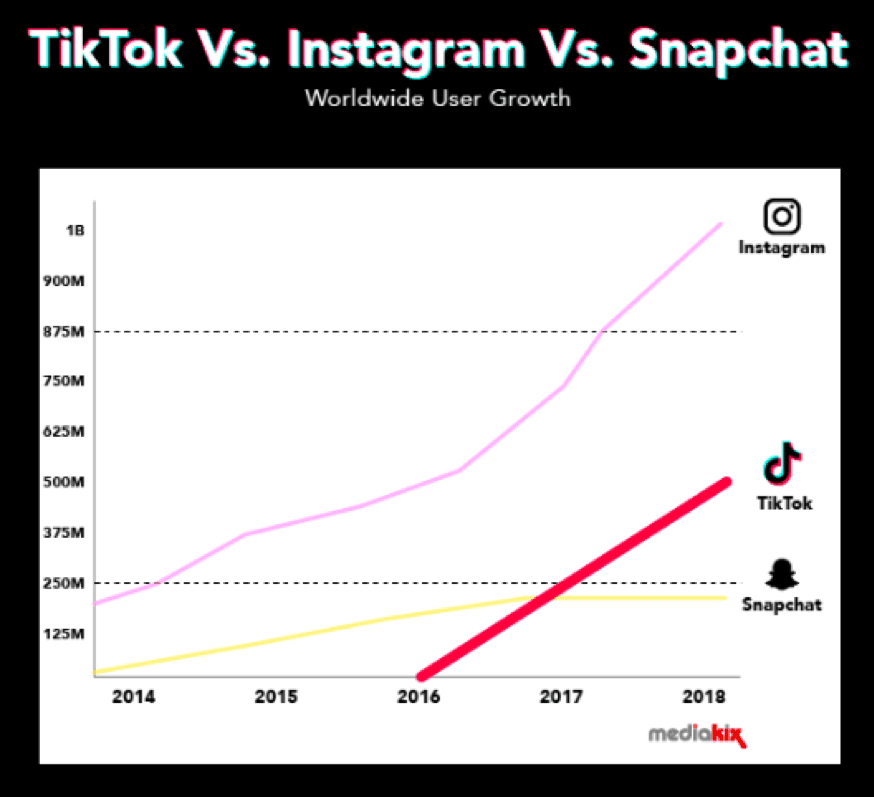With 1.2 billion installs globally and over 800 million monthly active users, TikTok is the newest social platform grabbing massive consumer attention – especially among Gen Z, with 80 percent of TikTok’s user base under 34 and 69 percent under 24. The platform growth has been rapid, to say the least, boasting a 275 percent increase year-over-year with little signs of slowing.

Source: MediaKix
So, what is TikTok and how does it work?
TikTok came to the US in August 2018, when the Chinese-owned platform from parent company ByteDance merged with the Musical.ly platform. The platform’s ability to capture Gen Z’s attention has made ByteDance the most successful internet startup in the world, currently valued at $75MM.
At its core, TikTok is an app for making and sharing short, vertical videos. Users of the platform have basic editing tools and filters along the ability to add sound and music. The music library is seemingly endless, and the editing tools are easy to use, making the platform a bit of a Snapchat meets Spotify hybrid. TikTok hasn’t reached the scale of its US competitors (Instagram and Facebook), yet users are spending 47 minutes per day on the app on average, more than any other platform by at least five minutes, with Gen Z users spending close to three hours per day.
Unlike other social networks that only shows you content from people you follow, TikTok is driven by its “For You” feed, which continuously aggregates and updates the content being shown. The feed’s algorithm gets smarter the more users consume and engage, allowing them to discover new people and interests all the time. To put that into perspective, it’s like Instagram Explore or trending topics on Twitter being front and center. It is content and engagement first and foremost. Followers, reach, popularity, and influence all come second.
Content on TikTok is as varied and wild as it’s user base: singing, lip-syncing, dancing, comedy sketches, pranks, trick shots, stop motion artists, athletes, or just everyday kids showing off their creativity or a mundane slice of life. And, did I mention, there is no shortage of memes. In recent months, TikTok content has started to go viral other social channels, racking up millions of views on Twitter and Instagram. Some TikTok compilation videos have tens of millions of views on YouTube. Although the platform was built to allow the masses to create, there are now “creators” who have risen to the top of the proverbial charts and are now garnering the attention of major brands. Send yourself down the rabbit hole with this Buzzfeed round up.
TikTok challenges have become increasingly popular, where users encourage one another to record themselves participating in creative and funny challenges. The now infamous #HariboChallenge has garnered over 32MM video views, all born from one user arranging two hundred gummy bears singing Adele’s “Someone Like You.” Celebrities are getting in on the action too! Jimmy Fallon was one of the first when he kicked off the comic #TumbleweedChallenge, which generated over 8,000 submissions. And brands have been following suit with the likes of Google, Nike, GymShark, Sephora, Coca-Cola launching challenges and buying up ad space on the platform.
TikTok is most frequently compared to the now defunct, Vine. Vine was acquired by Twitter for $30MM and was shutdown not long after, in December of 2016. But, if you believe the trendlines, TikTok has learned from its predecessors and is poised to build on its meteoric rise while brands continue to buy up ad space and debut new challenges on this emerging social goliath.


